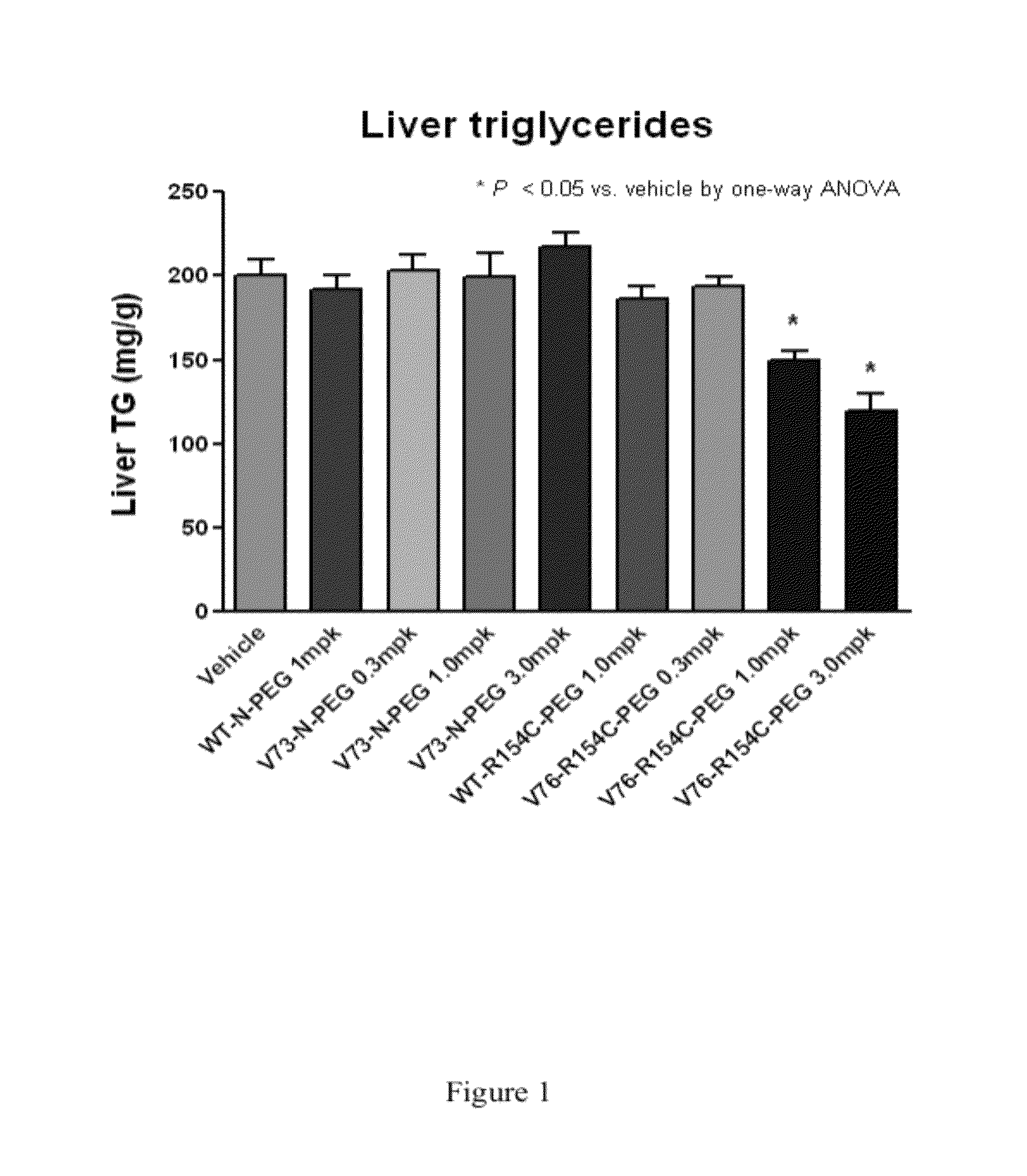Fibroblast growth factor 21 mutations
a growth factor and fibroblast technology, applied in the field of new polypeptides of fibroblast growth factor 21, can solve the problems of short half-life, adverse effects of m-cresol, and adverse effects on stability of m-cresol, and achieve the effect of enhancing the biological properties of the variants
- Summary
- Abstract
- Description
- Claims
- Application Information
AI Technical Summary
Benefits of technology
Problems solved by technology
Method used
Image
Examples
example 1
Preparation and PEGylation of FGF21 Variant Proteins
[0236]Expression constructs for FGF21 variants: The FGF21 variants were cloned into the modified E. coli expression vector pET30a, described by Achmuller et al. (2007) (Nature Methods 4:1037-1043), to generate in-frame fusions to a hexa-histidine tag followed by the Npro-EDDIE tag at the N-terminus of FGF21 (aa 33-209).
[0237]Expression and purification of FGF21 variants: The pET30a-His-Npro-EDDIE-FGF21 expression plasmid was transformed into E. coli BL21 Star (DE3) competent cells (Invitrogen). Overnight growth from a single colony of freshly transformed cells was carried out in 50 mL of Terrific Broth (TB) containing 50 μg / mL of kanamycin at 37° C. The pre-culture was transferred into 1 L of TB medium with kanamycin and cultured in baffled flasks at 37° C. with shaking at 250 rpm. After 6 hour of culture, expression of FGF21 was induced by the addition of IPTG at a final concentration of 1 mM, and the cultures were grown overnight...
example 2
Generation of human FGF21 Disulfide Variants
[0242]Cloning library: The vector pGAPZalphaA (Invitrogen, Carlsbad, Calif.) was modified by adding a β-lactamase expression cassette in the vector's unique BamHI site. The β-lactamase expression cassette was generated as described by Hribar, et al (2008) BioTechniques 44:477-84. The human FGF21 cDNA encoding amino acids 33 to 209 was cloned into the modified pGAPZ alphaA vector after the glyceraldehyde-3-phosphate dehydrogenase (GAP) promoter in frame with N-terminal sequences including an alpha mating factor secretion signal sequence, a six histidine affinity purification tag, and a Tobacco Etch Virus (TEV) protease recognition sequence. A library of hFGF21 constructs was generated with each construct having Cys 103 and Cys121 that are in the wild-type sequence as well as two wild-type amino acids that were mutated to cysteines. The library was made by generating PCR fragments of the hFGF21 amino acid 33-209 coding region with primers th...
example 3
Measuring 2-Deoxyglucose (2-DOG) Uptake
[0251]More recently, FGF21 has been shown to stimulate glucose-uptake in mouse 3T3-L1 adipocytes in the presence and absence of insulin, and to decrease fed and fasting blood glucose, triglycerides, and glucagon levels in ob / ob and db / db mice and 8 week old ZDF rats in a dose-dependent manner, thus, providing the basis for the use of FGF21 as a therapy for treating diabetes and obesity (see, e.g., patent publication WO03 / 011213, and Kharitonenkov et al., (2005) Jour. of Clinical Invest. 115:1627-1635). Also, FGF21 was observed to stimulate tyrosine phosphorylation of FGFR-1 and FGFR-2 in 3T3-L1 adipocytes.
[0252]T3-L1 fibroblasts were purchased from ATCC (Catalog #CL173). The cells were grown to confluency in 150 cm petri-dish and were maintained in DMEM with high glucose (Invitrogen #11995065) supplemented with 10% Fetal Bovine Serum and 1% penicillin-streptomycin for an additional 4 days. Cells were then differentiated in the above media suppl...
PUM
| Property | Measurement | Unit |
|---|---|---|
| temperature | aaaaa | aaaaa |
| time point | aaaaa | aaaaa |
| diastolic blood pressure | aaaaa | aaaaa |
Abstract
Description
Claims
Application Information
 Login to View More
Login to View More - R&D
- Intellectual Property
- Life Sciences
- Materials
- Tech Scout
- Unparalleled Data Quality
- Higher Quality Content
- 60% Fewer Hallucinations
Browse by: Latest US Patents, China's latest patents, Technical Efficacy Thesaurus, Application Domain, Technology Topic, Popular Technical Reports.
© 2025 PatSnap. All rights reserved.Legal|Privacy policy|Modern Slavery Act Transparency Statement|Sitemap|About US| Contact US: help@patsnap.com



